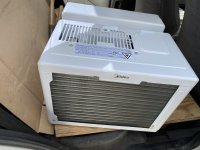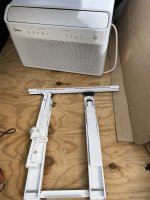There are several things I have used for significant noise reduction on a room used for home studio audio recording, enough to be able to leave it running while recording louder audio sources and still get a usably clean recording. These all assume a unit with intake on the lower portion of the front panel, and output on the top portion of the front panel, and controls on the side of the front panel. If yours is different, you will have to adapt them to yours.
It's a lot of work, and not worth it for most people.
Remove the front panel of the AC unit. If there is intake filtration in this part of it, you may need to cut away this portion so it can be left on the unit to keep the filtration (you need this), but move the filtration to the intake part of the duct you will build in a step below.
Cut part of the top of the AC unit away, starting from the edge that meets the front panel, back to the back wall of the unit's squirrel-cage circulation fan box. This is so the SC fan can move more air more freely, with less turbulence and thus less noise.
If there is a grate or other protective wire cover over the rear exhaust fins (the ones on the outside that get hot during operation), you can unbolt it from there and move it away from the fins to decrease the exhaust fan noise.
If you can protect the interior of the unit from rain and other intrusions in another way farther from the unit's casing, you can cut away the intake grilles for this external fan, and that will also reduce noise. (if you don't have anything there to keep thigns out, birds or other animals may nest in it when not running and get killed when the fan turns on; they may also damage the wiring/etc).
Mount the window unit on a standalone frame not attached to the house, but instead rising from the ground. If you have to mount it to the house, then you'll have to live with the low-frequency vibration it's going to induce into the walls.
The unit only has to be inches away from the house, just not touching it. A foot away from the house gives you clearance to make the duct below, and work with / on the unit if ever needed. If you want more noise reduction from airflow, turn the unit 90 to 180 degrees away from the house so the duct will have to route air in an elbow or U shape, which can significantly decrease fan noise in the airstream.
Then use layers of styrofoam (either sheet insulation or old flat-sided coolers) to make a divided duct attached to the AC unit (permanently using sprayfoam, for instance, or temporarily using other methods). Make the duct not quite touch the house. Line the entire interior of the duct with noise-reducing materials; you can use commercial ones or DIY these (see the many webpages/forums for reducing noise in home recording studios for numerous options). If it is not fairly dry where you live, you will need to cover the outside of the styrofoam with something to keep it dry, or it will absorb water and become mildewed, and likely eventually penetrate into the inside and make you sick. (it is very dry here so I don't have to worry about that).
The AC-end of the duct needs to be tall, with the "wall" that mounts to the top of the AC unit behind the SC fan box cut line angled forward from there at >45 degrees (anything up to vertical 90) so the SC fan air is able to cleanly exit the SC fan box area, and then be redirected into the horizontal duct. If you can make this a curve, even better, but it works as a flat surface if you have to do it that way.
The divided duct will need to have 2/3 of it's volume for the intake, and 1/3 for the output. (you can make it half and half but this may makes more noise, depends on a bunch of factors). It has to be divided or it will only cool the duct, and not the room. The divider needs to extend into the room itself, for at least a foot, so that the cooled air is not pulled right back into the intake. You will probalby need to make vanes on the output side to push the air at an angle away from the intake.
The duct should change size and shape smoothly from the front and top of the AC unit to the window's full opening size and shape. The bigger the window opening, the better, as it will decrease the air speed required and this decreases noise.
Then use a layer of squishy low-density foam (like weatherstripping for doors) to complete the connection to the window. This prevents vibrations of the unit from vibrating the house, which will make a huge difference in low-frequency noise (which you may not perceptibly "hear" but you will notice when it is not there). I recommend doing this to the divider as well, at the point it enters the window, just like the rest of the duct, so that it doesn't pass vibrations into the house via the divider. The internal divider portion will mount to the window itself.
I recommend mounting the intake filtering unit from that front panel you removed from the unit on the intake portion of the above, at the inside of the window. That way you can still clean it as needed. (if you don't use the intake filtering, you'll have to clean the actual unit's intake condenser fins, and that is a PITA job to do; without cleaning them they'll clog up with dust and the unit will stop working).
The control panel that you took off the front of the unit with the rest of it's face will mount on the inside of the window, and you will make an extension cable from it to the unit itself. Depending on the window shape and your duct design, you may be able to simply mount the entire front panel including the intake filtering on the inside of the window.
Exactly how any of these are done will depend on your unit, your house / window, the ground and conditions outside, and your materials availability, DIY skills, budget, etc. You may need other adaptations as well.
If you have direct sunlight on the AC unit, and/or high outside air temperatures, I recommend at least doubling the thickness of the duct walls with the styrofoam insulation, and using more of it to create a shade panel over the top of the whole unit and as much of the sides as you can, that stands away from it far enough to allow good air circulation to and from it's exterior intake and outlet ducts.
If the unit has a noisy compressor or external fan, you may have to insulate the entire non-opening portion of the window against vibration so it does not pass the outside noises on to the room. The simplest way to do this is a large block of thick foam (like many couch cushions or foam mattresses are made of) completely filling the entire window area that is not occupied by the duct/opening, preferably so it contacts all the window glass so the glass can't vibrate.
The point of the modifications is to decrease vibration from the unit to the house, and decrease turbulence in the airstreams both intake and output, on inside and outside, which all reduces noise.
If there is insufficient airflow due to too small / long a duct, you can increase it by installing a "wall" of large-surface-area computer case fans, at least 7-8" diameter, run on 5-7v, instead of their intended 12v, to reduce their speed and noise/vibration. Power each fan at a slightly different voltage, so they are not in sync and don't "thrum" from resonance (or use all different brand/design/RPM fans). Use Nidec or other good quality fans with bearings, not bushings, that are designed for quiet operation. The "wall" of fans needs to fit closely together and right to the edges of the output duct, so no air backflows around them. They need to pull air out of the duct so that then pulls more air into the duct (pushing air rather than pulling will make more noise and works less well).



